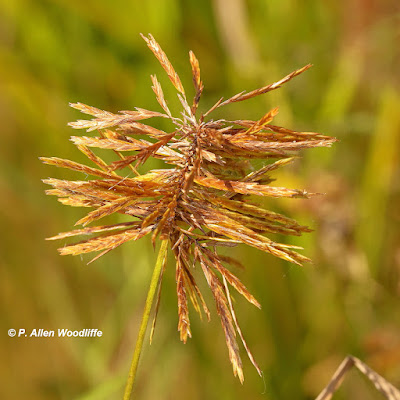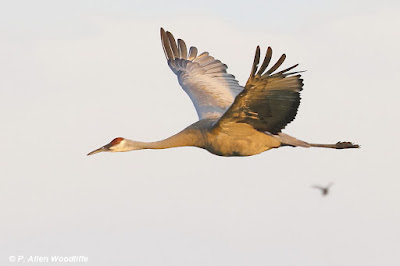On one of my recent excursions to St. Clair NWA, I came across a plant that was not abundant, but scattered here and there along the cross-dyke trail. After photographing it and searching its identity, I came to discover that it is Marsh Tickseed (Bidens trichosperma). I had never seen it, or at least never noticed it before. It is considered Imperiled in Ontario and Canada.
While at first glance, it could easily just be passed off as a sunflower type, which it is, the key characteristic to note is the large, but finely divided leaves, unlike any other sunflower type that I am aware of.Of course any visit to SCNWA will turn up other things to aim the camera at, including:
 |
| Northern Harrier |
While some of the Sandhill Cranes will be out feeding or resting outside the NWA, sometimes mixed in with geese, they often fly into the NWA for over night, so being ready for them in the evening can be successful.
In checking the range and locations for the Marsh Tickseed, I found out that there are a couple of records for Rondeau. I had never seen it there before. Since this was prime time for it to be in flower, and most visible, I decided to check out similar habitat along the Marsh Trail at Rondeau.
While I was not successful in finding it there, yet, I have another location in the park to examine. But over the course of my 10 km hike, I did come across other things that I aimed the camera at.
 |
| Straw-coloured Flat Sedge |
 |
| Swamp Thistle |
 |
| White Turtlehead |
 |
| Smeared Dagger moth caterpillar on a sedge |
I only had my camera with the 100 mm macro lens so as to be able to photograph plants. Had I taken my other camera with the big telephoto lens, I could have gotten some great shots of a pair of adult Bald Eagles soaring not all that high up against a blue sky (much closer than this next photo, which was taken awhile ago)....
On another occasion, while searching for plants in the interdunal meadows of the southeast beach of the park, I came across a few things such as:
 |
| Bristly Sedge |
 |
| Common Buckeye caterpillar |
 |
| Little Green Sedge |
Along a drier trail I found these white forms of Great Blue Lobelia, usually a deep blue colour.
Along the Erieau Marsh Trail, I came across:
 |
| Least Sandpiper |
A visit to the Mitchell's Bay North Shore Trail enabled me to get much more open photos of Wood Duck....
...as well as another Common Buckeye...
...this Great Blue Heron...
...and of course one or more of the typical half a dozen Great Egrets that are often found and quite photogenic. This one had just grabbed a fish, which is still showing at the side of it beak.
Last but not least, I made a brief stop at the Keith McLean Conservation Lands, and while photo ops were not plentiful on the visit here this particular time, I did manage to capture one of this Ruby-throated Hummingbird perched at the top of this dogwood shrub.
If you would like to subscribe, or unsubscribe, to Nature Nuggets, send an email to: prairietramper@gmail.com




















An interesting find; the Marsh Tickseed. The bud and the flower remind me of a common garden plant in Africa and here in NZ too; Cosmos.
ReplyDeleteThanks, Paula!
DeleteAllen, is there anywhere in London where you can buy your books? Chatham? Is a purchase by mail an option?
ReplyDeleteAt this point they are not available anywhere in London. They are available at several places in Chatham-Kent, including two in Chatham (Book Brothers, King St., as well as Lavender & Honey, also on King St.)
DeleteMailing is an expensive option. Life on a Sandspit is a smaller, lighter weight book and in the past I have mailed it for about $6. Natural Treasures is a heavier book and when I did mail one shortly after it first came out, Canada Post charged almost $20 for it.